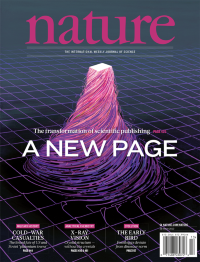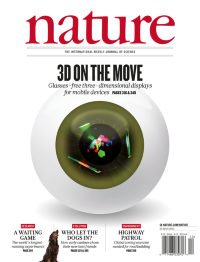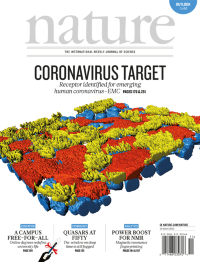Volume 495
-
No. 7442 28 March 2013
This special issue of Nature looks at the transformation taking place in scientific publishing. A News Feature weighs claims that online, author-pays publishing can drastically cut costs, and several authors discuss how they make open-access publishing work for them. The special also looks at broader aspects of publishing, including the idea that the concepts of journal and article are being superseded by real-time filtering algorithms and what the future holds for libraries or their virtual successors.
-
No. 7441 21 March 2013
Glasses-free three-dimensional (3D) displays could revolutionize areas such as data visualization, medical training and entertainment, particularly if adapted to mobile devices. Holography can provide ideal 3D viewing but is too slow or expensive for many applications. Multiview approaches are the alternative, exploiting various geometric optical tricks to create 3D images that can be viewed from many directions at the same time. A team working at Hewlett-Packards laboratories in Palo Alto has developed a new multiview 3D display that is particularly well suited to mobile devices, which require thin displays with high spatial resolution and a wide-angle view zone. Central to the new device is a set of directional grating pixels, associated with different views and colours, etched on the backlight surface. The display uses an LED-lit backlight very similar to those in use in LCD screens today, and is demonstrated in action in transparent hand-held prototypes showing animated sequences of up to six different 200-view images at a resolution of 127 pixels per inch. The cover image represents a 3D image from a passively modulated backlight.
-
No. 7440 14 March 2013
The emerging pathogenic coronavirus hCoV-EMC, first identified in September 2012, has been fatal in about half of the few humans infected so far. Bart Haagmans and colleagues have now identified the receptor that this virus uses to infect cells. In contrast to the related virus SARS-CoV, which uses angiotensin converting enzyme 2, the functional receptor for hCoV-EMC is dipeptidyl peptidase 4 (DPP4, also known as CD26), an exopeptidase found on non-ciliated cells in the lower respiratory tract. This enzyme is highly conserved across different species, and hCoV-EMC can also use bat DPP4 as a functional receptor a possible clue as to the host range and epidemiological history of this new virus. The findings may also be important for the development of intervention strategies. The cover represents dipeptidyl peptidase 4 (red), the functional coronavirus-EMC receptor, on non-ciliated cells but not on ciliated cells (yellow) in primary bronchiolar epithelial cell cultures.
Nature Outlook
-
No. 7439 7 March 2013
Science remains institutionally sexist. Despite some progress, women scientists are still paid less, promoted less, win fewer grants and are more likely to leave research than similarly qualified men. In this special issue, Nature takes a hard look at this gender gap and at what is being done to close it. This issue is dedicated to the memory of Maxine Clarke. In the 28 years Maxine spent championing the highest scientific standards as an editor at Nature, she was all too often the only one to ask, "Where are the women?" Cover: Viktor Koen




